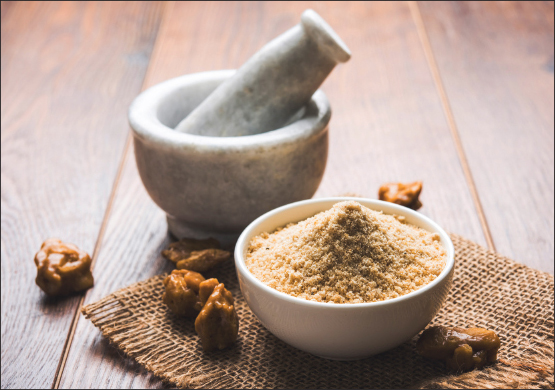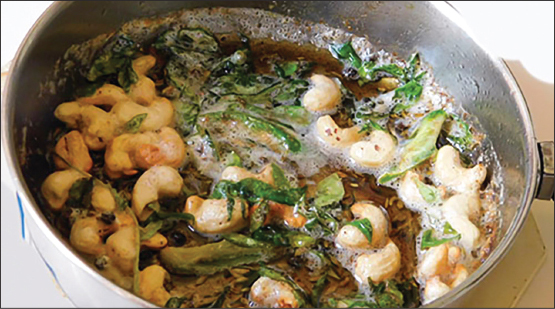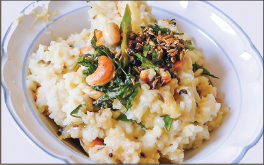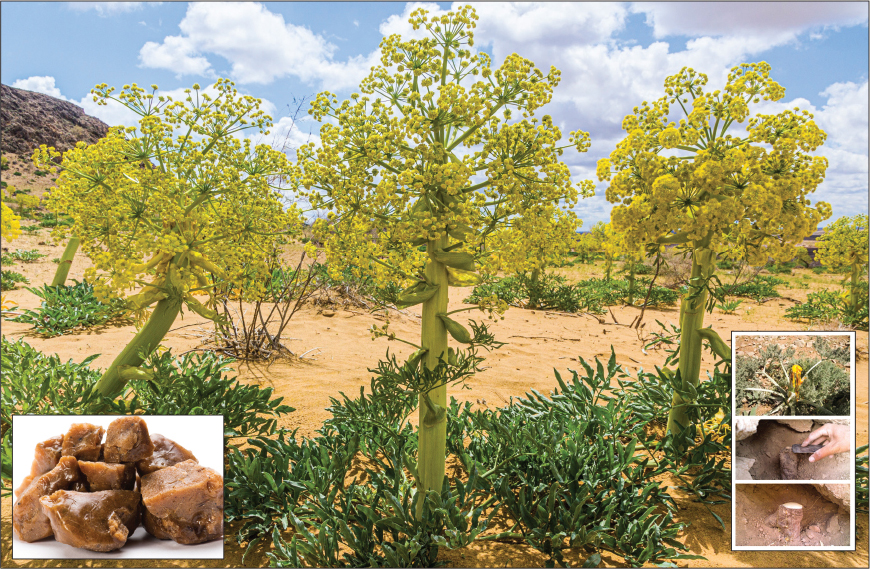This pungent ingredient brings a full and savory flavor to a wide variety of Indian curries, condiments and pickles
Strange as it may seem, asafoetida, now so essential to Indian cooking, is actually an ancient Roman spice. Their traders brought it to the Chola, Chera and Pandya dynasties of South India beginning in at least 300 bce. The plant it is derived from, Ferula asafoetida, is native to central Asia and grown today chiefly in Iran and Afghanistan. India imports $100 million worth each year. Attempts to grow it on a commercial scale on the subcontinent are so far unsuccessful.
The Latin name ferula means “carrier” or “vehicle” and asafoetida, literally, “stinking gum.” In recognition of its myriad good properties, it is more generously called “Food of the Gods.” It is called hing in Sanskrit and Hindi and is the major component in the famous Ayurvedic herbal formula Hingashtak. Quite a few spices, such as ajwain, fennel, cumin, chervil and dill, belong to the same family, apiacaeae.
The plant is a tall perennial; growing up to six feet in dry rocky soils. It has massive carrot-shaped taproot, about four to six inches in diameter at the crown when four to five years old. The extraction of the gum is a laborious process. Just before plants flower, in March-April, they are cut off near the base. A milky juice exudes from the cut surface. After some days, this is scraped off and a fresh slice of the root is cut. This process is repeated over several months; the plant is then allowed to regrow.
Commercially, asafoetida is available as a solid gum or powder. Typically, the asafoetida compound contains the resin powder, rice flour and gum Arabic. The solid gum needs to be cracked with a hammer or stone, then soaked in hot water. It is very pungent.

Culinary uses
Hing is essential to Indian cuisine. It is introduced during the spice tempering process, the first step in making a soup, stew, stir frying vegetables, sauce or pickle. Tempering means to heat a spice, either dry or in oil, to cook it and release its flavor. Commonly, mustard seeds are “popped” first in oil, then cumin added and then asafoetida. By itself, hing does not have a pleasant odor. However, when heated and combined with other spices, it enhances the flavor and aroma in a manner comparable in effect to leeks or garlic.
Asafoetida is called for in thousands of dishes. A search on the recipe site yummly.com produces 3,527 recipes using the spice. One famous North Indian street-food snack using it is pani puri. These are a hollow, deep-fried flatbread filled with spiced potatoes, onions or chickpeas. In a hing-centric version, it is then dipped into a thin paste made with mint leaves, coriander leaves, green chillies, tamarind pulp, jaggery, black salt, cumin powder, chat masala, red chili powder and hing (see bit.ly/hingvideo).
According to a comprehensive 2012 article by Poonam Mahendar and Shradha Bisht in the journal Pharmacognosy Review (bit.ly/-hing) the Iranians use hing as a condiment by mixing it with almost all their dishes. French gastronomes rub a little asafoetida on hot plates from which they eat meat. When used with discretion, it adds character to curries, stews, gravies, etc. The distinctive flavor of Worcestershire sauce comes from asafoetida. It is also, and most unexpectedly, according to the same article, a useful ingredient in fine perfumes.

Health benefits
At his website, www.ayurtimes.com/hing/, Dr. Jagdev Singh goes into the myriad uses of asafoetida. “The health benefits of hing are attributed to its digestive, carminative, emmenagogue and analgesic actions. It benefits for improving appetite, releasing gas, and promoting digestion.” He goes on to detail its use in disorders as varied as sciatica, high cholesterol, both high and low blood pressure and dental health. Other sources consider it useful in the treatment of health problems of women such as sterility, miscarriage, pre-mature labor, unusually painful, difficult and excessive menstruation and leucorrhoea.
Used in small quantities in food, it is unlikely to have any deleterious effect, but for higher doses, it is always best to consult a knowledgeable physician.
Pongal Recipe

Pongal
The star item in the Makara Sankranthi feast, pongal, is rice cooked with moong dal, spiced with black pepper, cumin and asafoetida and garnished with cashews roasted in ghee.
Preparation time: 5 minutes
Cooking time: 35 minutes
Serves: 5
Ingredients
2 cups rice
¼ cup split moong dal
1 tsp whole black pepper
1 tsp cumin seeds
A small cube of asafoetida resin
1 inch ginger, chopped
½ cup roasted cashews
1 tbsp curry leaves
½ cup clarified butter
1 tsp salt
Method
1. Cook rice and moong dhal together in a pressure cooker with five cups water and salt. Excess water is always used when making pongal. It is ok if the pongal is a little mushy.
2. Temper the spices. This adds the unique aroma, flavor and taste to pongal. First, soak the asafoetida in 1 tbsp of boiling water, then crush it with a pestle. Add black pepper to 1 tbsp hot ghee in a saucepan over medium heat for two minutes until it pops. Add cumin, asafoetida, cashews, curry leaves and ginger for another two minutes.
3. Remove from heat. Add this to the cooked rice and moong dal. Add the remaining ghee, salt to taste and mix thoroughly with a spoon.
About the Author
Lakshmi Sridharan is an American scientist of South Indian origin who lives in San Jose, California, with her husband Tim. As a freelance writer, she enjoys sharing with others her knowledge in plant science, culinary science, her experience in gardening and cooking as well as Indian culture and traditions.
